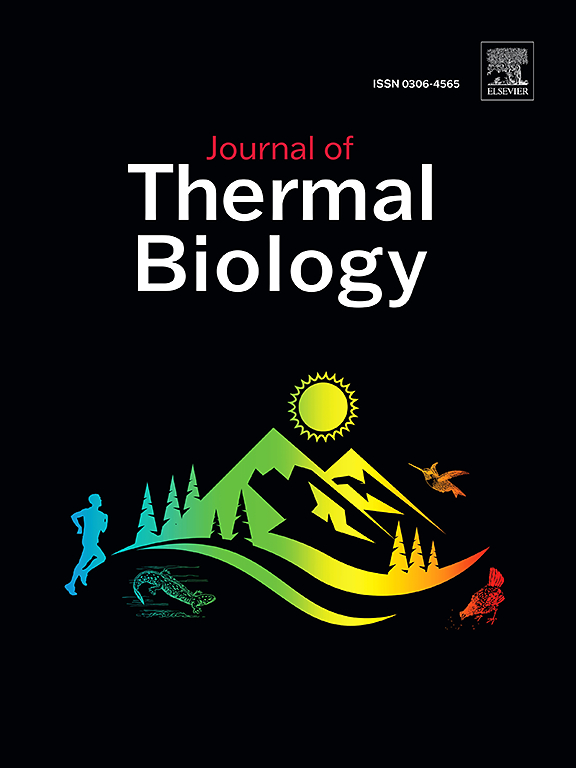Effect of aerobic fitness on the validity of the Calera Research™ sensor to estimate core temperature during exercise
IF 2.9
2区 生物学
Q2 BIOLOGY
引用次数: 0
Abstract
The Calera Research™ is a heat flux device advertised to estimate core temperature (Tc) during physical activity and is widely used by athletes in various sport disciplines. The device estimates Tc from skin temperature, heart rate, and heat flux, outcomes that can be affected by aerobic fitness. However, there is a relatively small body of literature exploring its validity and, specifically, how the device bias may be influenced by aerobic fitness. The objective of this study was to assess the validity of the Calera Research™ sensor compared with telemetric ingestible pills for estimating Tc and to determine whether aerobic fitness impacts accuracy. Twenty participants (10 females) performed a cycling-based ramp-incremental exercise test to volitional exhaustion in a temperature controlled environment (22 °C) during which Tc was measured directly from ingested pills (eCelsius performance system) and by the Calera device. Compared to the ingestible telemetric pills, the Calera device exhibited lower Tc values (95%CI[-0.2, -0.3 °C], p < 0.001) with an intraclass correlation of 0.47 and a bias of −0.3 ± 0.2 °C. Participants were divided into two groups (10 participants at each group) based on peak oxygen uptake ( O2peak) (HL: high aerobic; LL: lower aerobic fitness). Throughout ramp-incremental exercise, HL had a lower heart rate (p < 0.001 and η2 = 0.10; 95%CI[0.1, 17.2 bits/min]) and Tc measured by the ingestible pills (p < 0.001 and η2 < 0.01, 95%CI[0.1, 0.3 °C]). However, there were no-between group differences for skin temperature and intraclass correlation values and bias were also similar. In conclusion, the estimation of Tc by Calera Research™ underestimated Tc by approximately 0.3 °C in a moderate thermal environment, but the intensity-dependent profile was similar to that of the ingestible pill method and was unaffected by aerobic fitness differences.
有氧健身对Calera Research™传感器在运动中估计核心温度的有效性的影响
Calera Research™是一种热流通量装置,用于估计身体活动期间的核心温度(Tc),被各种运动学科的运动员广泛使用。该设备通过皮肤温度、心率和热通量来估计Tc,这些结果可能受到有氧健身的影响。然而,有相对较少的文献探讨其有效性,特别是有氧适应度如何影响设备偏差。本研究的目的是评估Calera Research™传感器与遥测可摄取药丸在估计Tc方面的有效性,并确定有氧健身是否会影响准确性。20名参与者(10名女性)在温度控制的环境(22°C)中进行了基于自行车的坡道增量运动测试,直到意志衰竭。在此期间,Tc直接通过摄入的药丸(eCelsius性能系统)和Calera设备测量。与可摄取遥测药丸相比,Calera装置的Tc值更低(95%CI[-0.2, -0.3°C], p <;0.001),类内相关性为0.47,偏差为- 0.3±0.2°C。受试者根据摄氧量峰值(V˙o2峰值)分为两组(每组10人)(HL:高氧;李华学了两个常用语。在坡道增量运动过程中,HL的心率较低(p <;0.001, η2 = 0.10;95%CI[0.1, 17.2 bits/min])和可消化丸测Tc (p <;0.001和η2 <;0.01, 95%ci[0.1, 0.3°c])。然而,皮肤温度和类内相关值在组间无差异,偏倚也相似。综上所述,在中等热环境下,Calera Research™对Tc的估计低估了约0.3°C,但强度依赖曲线与可摄取药丸方法相似,并且不受有氧适应度差异的影响。
本文章由计算机程序翻译,如有差异,请以英文原文为准。
求助全文
约1分钟内获得全文
求助全文
来源期刊

Journal of thermal biology
生物-动物学
CiteScore
5.30
自引率
7.40%
发文量
196
审稿时长
14.5 weeks
期刊介绍:
The Journal of Thermal Biology publishes articles that advance our knowledge on the ways and mechanisms through which temperature affects man and animals. This includes studies of their responses to these effects and on the ecological consequences. Directly relevant to this theme are:
• The mechanisms of thermal limitation, heat and cold injury, and the resistance of organisms to extremes of temperature
• The mechanisms involved in acclimation, acclimatization and evolutionary adaptation to temperature
• Mechanisms underlying the patterns of hibernation, torpor, dormancy, aestivation and diapause
• Effects of temperature on reproduction and development, growth, ageing and life-span
• Studies on modelling heat transfer between organisms and their environment
• The contributions of temperature to effects of climate change on animal species and man
• Studies of conservation biology and physiology related to temperature
• Behavioural and physiological regulation of body temperature including its pathophysiology and fever
• Medical applications of hypo- and hyperthermia
Article types:
• Original articles
• Review articles
 求助内容:
求助内容: 应助结果提醒方式:
应助结果提醒方式:


